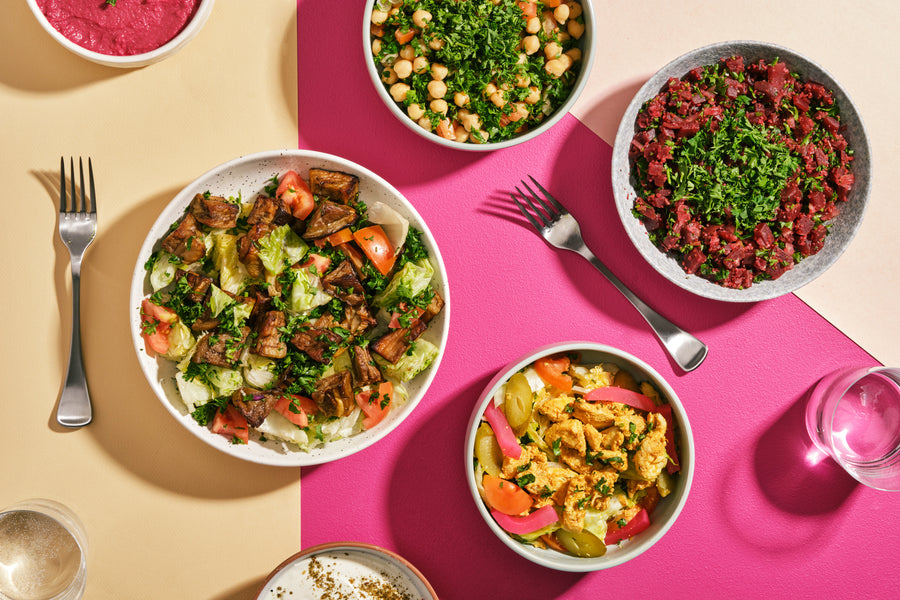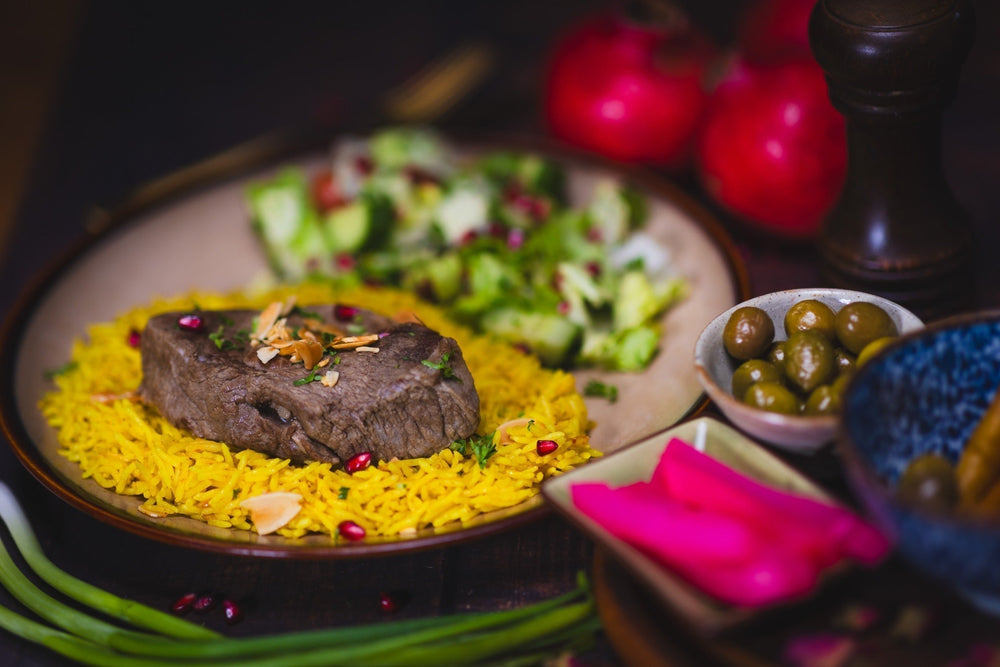All Regarding the Rich Flavors and Traditions of Syrian Food: A Culinary Journey
Syrian food provides a distinct blend of flavors and traditions that reflect its abundant social background. With staple ingredients like olive oil and garlic, together with a variety of spices, the dishes are both diverse and inviting. From the detailed preparation of kibbeh to the wonderful appeal of baklava, each element of this cooking landscape reveals deeper stories. As one explores the significance of these tastes, a greater understanding of public dining and party arises.
The Significance of Syrian Components
The significance of Syrian ingredients exists in their rich diversity and ingrained social significance. Influenced by the country's different location and history, Syrian cuisine integrates a large variety of spices, natural herbs, and fresh fruit and vegetables. Staples such as olive oil, garlic, and lemon give a structure, while spices like coriander, sumac, and cumin add deepness and complexity to dishes.The use of fresh natural herbs, consisting of parsley and mint, highlights the significance of seasonal ingredients. Furthermore, the area's productive soil returns a wealth of vegetables and fruits, such as eggplants, pomegranates, and tomatoes, which are indispensable to many dishes. Grains like bulgur and rice form the base of numerous dishes, emphasizing the value of these active ingredients in Syrian culture. This mix of flavors shows not just a cooking practice yet additionally a tapestry of historical influences, making Syrian ingredients vital to recognizing its cuisine's vivid character.

Iconic Cuisines of Syrian Food
Syrian cuisine is renowned for its renowned meals that display a rich tapestry of flavors and structures. Typical meze plates offer a range of small meals that tantalize the taste buds, while hearty primary programs offer rewarding centerpieces for dishes (Afternoon Tea Vancouver). To finish the experience, a selection of delectable treats adds a wonderful note to the cooking trip
Conventional Meze Plates

Hearty Main Courses
Passionate major courses act as the focal point of Syrian eating, showcasing a mix of tastes that mirror the country's rich culinary customs. Meals such as kebab hindi, featuring marinated lamb skewers, and the renowned mujaddara, a comforting combination of lentils and rice, highlight making use of aromatic spices and fresh active ingredients. An additional staple is the iconic kibbeh, made from bulgur wheat and minced meat, frequently offered in numerous kinds, consisting of baked, fried, or raw. In addition, the flavors of the land come active in dishes like packed vegetables, recognized as mahshi, which are loaded with rice, meat, and herbs. These primary training courses not just satisfy appetite however also tell tales of household celebrations and cultural heritage.
Delectable Treats Selection
A fascinating variety of desserts specifies the pleasant side of Syrian food, using an alluring end to any kind of dish. Amongst one of the most well known confections are baklava, delicate layers of phyllo pastry full of nuts and drenched in syrup, and maamoul, shortbread-like cookies frequently packed with days or nuts. Knafeh, a rich treat made from thin noodle-like pastry taken in syrup and layered with cheese, is a popular option, specifically during joyful events. Additionally, the great smelling and sweet rice pudding, referred to as roz bil laban, provides a soothing coating. These mouth-watering treats not only display the region's cooking knowledge yet likewise reflect the social heritage of Syria, making them cherished deals with in both restaurants and homes alike.
Traditional Cooking Techniques
Although modern-day conveniences have affected numerous cooking practices, conventional food preparation strategies continue to be important to Syrian cuisine. These approaches typically highlight the usage of fresh, seasonal components and concentrate on sluggish cooking to establish rich tastes. Techniques such as cooking, braising, and cooking are prevalent, allowing the natural preferences of the ingredients to shine through.One remarkable method is the preparation of kibbeh, a meal made from carefully ground meat and bulgur. It requires experienced hand-rolling into various shapes and can be baked, deep-fried, or served raw. Furthermore, the art of making bread, particularly pita, is central to several dishes, commonly cooked in a traditional rock oven.Preservation methods like pickling and fermenting also play an important function, boosting the variety of tastes found in Syrian dishes. These strategies not only reflect the region's agricultural heritage yet also cultivate a solid feeling of community through shared cooking methods.

The Duty of Spices in Flavor
Spices serve as the heartbeat of Syrian cuisine, instilling dishes with intricate tastes and fragrant depth. Each flavor plays an essential function, contributing not only to preference however additionally to the cultural heritage of the area. Typically made use of spices consist of sumac, cumin, and coriander, each using an one-of-a-kind account that raises standard recipes. Cumin offers heat and earthiness, while sumac includes a tasty illumination, improving the overall dish.Syrian chefs typically mix seasonings to produce unified profiles, showing the detailed equilibrium of tastes that define the food. Using flavors is not just for flavoring; it likewise offers to maintain food and enhance its dietary value. This thoughtful unification highlights a deep understanding of the culinary arts, where a fantastic read seasonings become crucial authors, conveying the rich history and diverse impacts that characterize Syrian gastronomy. Inevitably, spices are essential in crafting unforgettable and authentic Syrian recipes.
Joyful custom-mades and congratulatory meals
Commemorative dishes in Syrian cuisine are noted by conventional feast meals that mirror the country's abundant culinary heritage. Special celebrations commonly entail one-of-a-kind routines that boost the public experience of eating. These customizeds not just honor the value of the events but also enhance familial and cultural bonds.
Traditional Feast Dishes
When households collect to celebrate substantial occasions in Syria, traditional feast meals take center stage, showcasing the rich cooking heritage of the region. These events commonly feature lively platters of mezze, including hummus, baba ghanoush, and tabbouleh, which serve as wonderful beginners. The primary training course normally highlights lamb or hen, marinated and cooked to perfection, usually come with by fragrant rice pilaf or bulgur. One of the most cherished dishes is maqlooba, a layered rice recipe with veggies and meat, flipped inverted prior to offering. Sugary foods likewise play a crucial function, with baklava and knafeh supplying a wonderful finish to the dish. Each recipe not only delights the taste buds however additionally mirrors the ingrained practices and communal spirit of Syrian society.
Unique Celebration Routines
Special celebrations in Syria are marked by abundant rituals that link food and celebration, reflecting the cultural significance of communal events. Celebratory meals frequently consist of conventional recipes such as kibbeh, tabbouleh, and various smoked meats, prepared with treatment and shared amongst household and good friends. Throughout spiritual vacations like Eid al-Fitr and Eid al-Adha, family members collaborated to prepare unique sugary foods like maamoul, representing unity and joy. Weddings are particularly fancy, featuring numerous programs and dynamic display screens of friendliness. These occasions are not simply about food; they encompass narration, music, and dancing, enhancing social bonds and cultural heritage. Via these routines, Syrians celebrate life's turning points, ensuring customs are given Read More Here via generations, improving their cooking landscape.
The Importance of Sharing and Area
Sharing dishes is a fundamental facet of Syrian society, mirroring the deep-rooted worths of community and link. In Syria, food is not simply sustenance however a way of bringing individuals together. Buddies and households gather around the table to take pleasure in traditional dishes, promoting bonds and creating long-term memories. This public eating experience stresses friendliness, where hosts most likely to great sizes to ensure every visitor feels invited and nourished.The act of sharing food likewise signifies kindness and solidarity, strengthening social ties within communities and larger neighborhoods. During gatherings, it prevails for people to serve each various other, showcasing a spirit of togetherness that goes beyond individuality. Parties, whether huge or tiny, are frequently noted by the sharing of dishes, where varied tastes and dishes integrated, showing the rich tapestry of Syrian society. Accordingly, the value of sharing and community in Syrian food is not only a culinary custom yet a critical social practice.
A Cooking Expedition of Syrian Sweets
Although usually eclipsed by tasty meals, Syrian sweets hold a cherished location in the country's cooking heritage. These confections reflect the area's rich history, mixing flavors and techniques from different cultures. Typical desserts like baklava, with its layers of phyllo bread, nuts, and honey syrup, display the creativity entailed in Syrian cooking. Ma'amoul, a shortbread-like cookie full of nuts or dates, is often prepared for joyful occasions, representing friendliness and celebration.Another beloved wonderful is Knafeh, a bread saturated in syrup and layered with cheese or lotion, providing a delightful comparison of textures. Syrians also enjoy a range of fruit syrups and protects, typically served with tea or as component of a bigger spread throughout celebrations. These sugary foods not only satisfy the taste buds however also function as a bridge in between generations, maintaining the practices and tales of Syrian culture with each delicious bite
Frequently Asked Inquiries
What Are the Wellness Advantages of Conventional Syrian Foods?
The wellness benefits of standard Syrian foods include rich nutrients from fresh vegetables, vegetables, and entire grains. These ingredients advertise heart health, improve food digestion, and supply crucial vitamins, adding to general health and a balanced diet plan.
Just How Has Syrian Cuisine Progressed For Many Years?
Syrian cuisine has developed considerably, influenced by historic trade routes, social exchanges, and local availability of active ingredients. Conventional dishes have actually integrated modern flavors and strategies while maintaining their abundant heritage, showing a varied culinary landscape.
Are There Vegetarian or Vegan Options in Syrian Cuisine?
Syrian food offers many vegan and vegan options, including meals like falafel, tabbouleh, and packed grape leaves. These dishes highlight the region's rich agricultural heritage, showcasing fresh vegetables, grains, and fragrant seasonings in lively combinations.
What Beverages Pair Well With Syrian Recipes?
When thinking about drinks that match Syrian meals, one might find that mint ayran, pomegranate, and tea juice improve the dish's flavors. Furthermore, merlot frequently pairs well with the spices generally discovered in these foods.
Exactly How Can I Recreate Syrian Dishes at Home?
To recreate Syrian meals in your home, one must check out authentic recipes, gather typical ingredients, and use cooking strategies one-of-a-kind to the food. Experimenting with flavors and presentation likewise improves the total eating experience. Syrian cuisine is renowned for its famous recipes that display an abundant tapestry of tastes and appearances. Seasonings offer as the heart beat of Syrian food, infusing dishes with intricate flavors and fragrant deepness. Celebratory dishes in Syrian cuisine are marked by standard feast meals that mirror the country's rich culinary heritage. Parties, whether big or tiny, are usually noted by the sharing of meals, where varied tastes and dishes come together, reflecting the abundant tapestry of Syrian society. Syrian food supplies countless vegetarian and vegan choices, including meals like falafel, tabbouleh, and Visit This Link stuffed grape leaves.